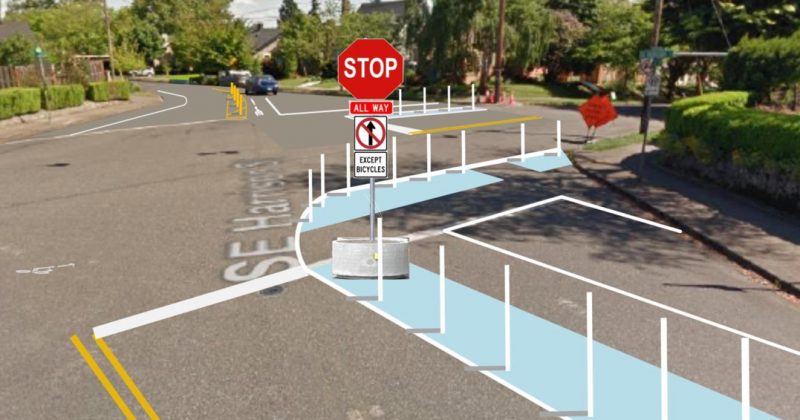
The Portland Bureau of Transportation announced changes to a key intersection on the Lincoln-Harrison Neighborhood Greenway yesterday. They also announced a delay for the infamous traffic diverter planned at 50th and Lincoln.
The project to update and improve this route began late last summer. It was triggered by concerns that the amount of people driving on what is supposed to be a “low-stress, family-friendly, bike route” was too high. The high speeds of auto users also drew the attention of PBOT staff.
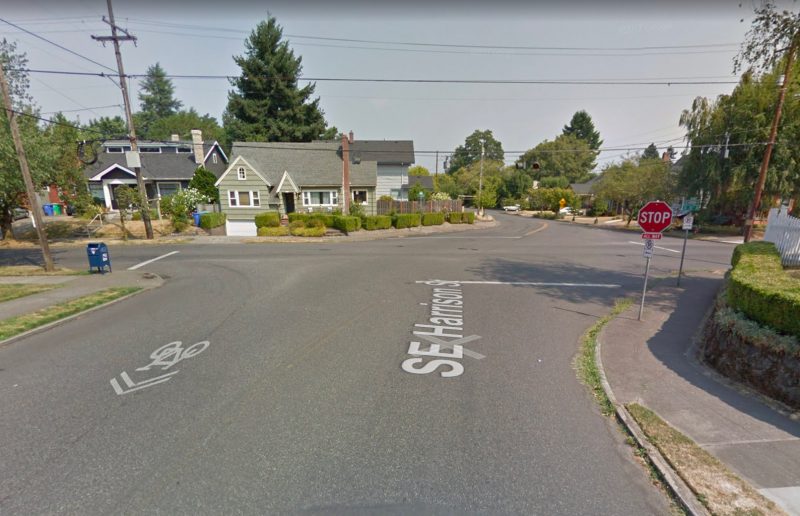
The intersection of 30th (where Lincoln becomes Harrison going west) is offset. As such, it has a wide profile that encourages speeding and unsafe driving behaviors. From the get-go, advocates urged PBOT to “square up” the corners to force people to make slower turns. There was also support to prevent people from turning onto Lincoln/Harrison from 30th in order to reduce the overall number of drivers on the greenway.
PBOT’s initial design was to simply make this a “sharrow crossing”:
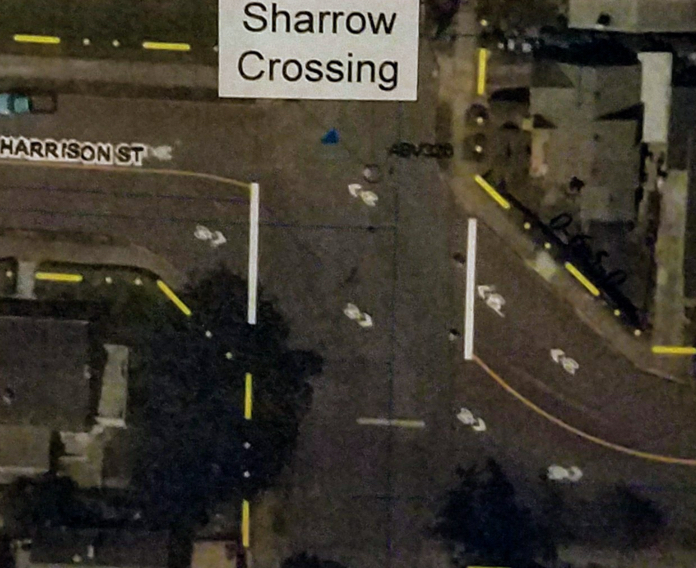
Then the design evolved into semi-diverter on the east side with enhanced crosswalk striping:

Advertisement
And here’s what PBOT unveiled yesterday:
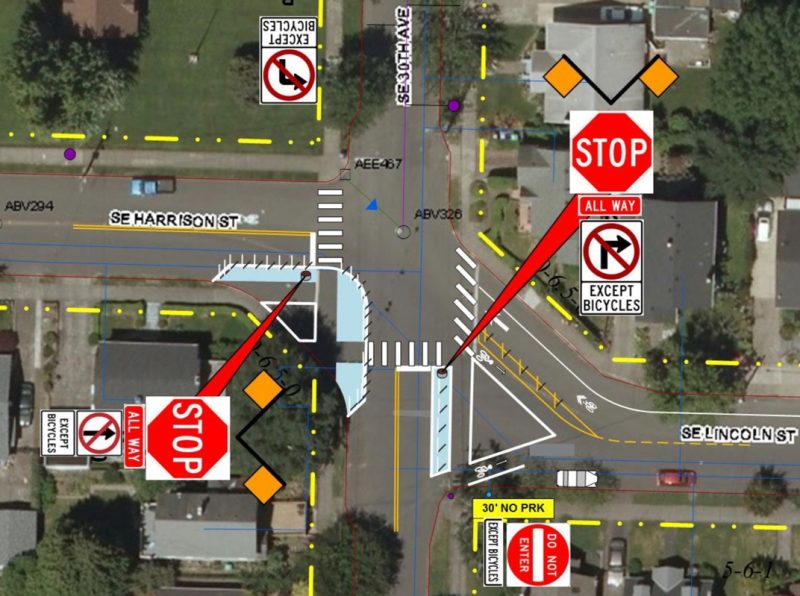
They new design prevents people from turning eastbound onto Lincoln from 30th or going straight from Harrison. Medians and plastic delineator wants on the southwest corner will slow down auto users while providing pass-through spaces for bicycle riders and walkers.
PBOT says this new design was created in response to community feedback and that it will, “further tighten the intersection and provide shorter crossings for pedestrians.”
At 50th and Lincoln, installation of diverters will be delayed due to the traffic management and paving plans of the contractor hired for a repaving project on 50th between Division and Hawthorne. PBOT wants to make sure any data they collect about traffic impacts due to the new diverter isn’t tainted by closures related to the repaving project. The diverters were initially slated to be installed on an interim basis this spring. Now PBOT says the construction will happen late summer with the permanent diverter to be built in spring of 2019.
In a statement about the delay, PBOT said they weren’t able to anticipate this conflict because they thought the paving project would work in sections and not have to close any lanes. Since a lane will be periodically closed, they felt it best to wait until after the paving project is completed. Learn more about the project on PBOT’s website.
— Jonathan Maus: (503) 706-8804, @jonathan_maus on Twitter and jonathan@bikeportland.org
Never miss a story. Sign-up for the daily BP Headlines email.
BikePortland needs your support.


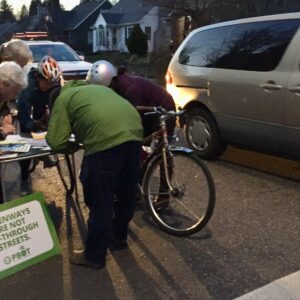
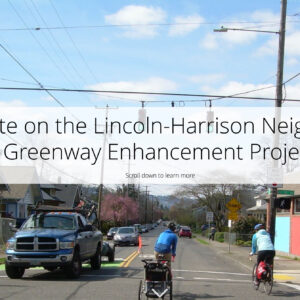
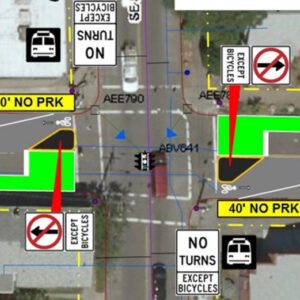
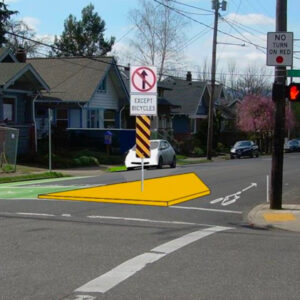
Thanks for reading.
BikePortland has served this community with independent community journalism since 2005. We rely on subscriptions from readers like you to survive. Your financial support is vital in keeping this valuable resource alive and well.
Please subscribe today to strengthen and expand our work.
That will never work, people are going to just drive right through that. And where is the eastbound traffic supposed to go if they don’t just drive right through? North on 30th to the next block and back around to SE Lincoln on SE 31st behind the diverter? Dealing with a plethora of traffic turning left onto SE Lincoln at SE 31st will be even less safe for cyclists, will piss off residents on the diversion route, and you know motorists are going to do it…
north on 30th is the Neighborhood Collector. 26th-Harrison-30th is the Neighborhood Collector between Division and Hawthorne.
Those designations mean nothing in light of this project, which will divert traffic from the neighborhood collector all sorts of other ways through the neighborhood on non-neighborhood collector streets, including 26th and Stephens north of Harrison, SE 31st and Stephens north of Lincoln, and many other neighborhood streets.
Although I realize the intent is to improve these streets for even the most timid of cyclists, PBOT is completely ignoring the ‘do no harm’ axiom on this and other similar projects, which have real negative impacts beyond the project’s narrow boundaries.
Your fear of what might happen has not materialized on similar projects. A couple hundred more cars on a street with only a couple hundred already is not anywhere near a death sentence, let alone harm.
PBOT is not a doctor, Portland is not a patient.
I disagree with you completely; you’ve got blinders on.
I don’t even know where to begin on this one. I hate being pessimistic here, and heck I’m a big supporter of traffic calming and diversion efforts in general, but this is a mess. My main complaint is that the plan chops away all the abundant space that actually lets this intersection work fluidly in the first place.
This is a spot I’d advise doing nothing. Second to ‘nothing’ my pick would be to convert to a traffic circle, removing all signs and putting some pretty plants in the middle.
I’ll admit, I don’t live on Lincoln any more, but spent like four years in a house at 48th and Lincoln commuting through this intersection twice a day.
That intersection is as wide as it is because that space was needed once upon a time for streetcar turning radius.
This intersection was supposed to be narrowed with actual hardscape years ago, it’s in the recommendations of the Hawthorne Blvd. Transportation Plan, but it never happened.
There is a similar wide intersection at Woodward and 59th. I’m surprised the city is reducing some of these intersections. In the past, they have cited the need to keep such intersections wide in order to provide turn-around room for large utility trucks or machinery and/or as a staging area for misc projects.
I’ve lived on Lincoln for 11 years and I can tell you that Lincoln and in particular this stretch from 30th to 39th eastbound has gotten significantly worse over the past few years. Call it the Waze/Lyft/Uber/changes-to-Division-and-Clinton perfect storm. There does need to be some diverter here for Eastbound traffic.
That said, the biggest problem with this intersection is for peds trying to cross 30th on the south side of the intersection. Right now cars stop 10 feet past of where the SE curb is, which is a mess. I’ve almost been hit here more often as a ped than a bicyclist (and I go through this intersection 10 times more often by bike). They need to bring the curb and the sidewalk on the SE corner all the way up to the edge of the “triangle” in the picture above. Otherwise peds are still going to walk yards in an unprotected intersection.
S,
If you are familiar with the street topography, and traffic circle design, you’d know that would not work.
This is in my experience the most sketchy intersection in this project due to excessive space. Drivers see all that space and emmediatly increase driving speed and agressiveness. The design could be greatly simplified by eliminating as much extra space as possible. I don’t see a need for diversion. Center islands and bioswales work great.
Well that design is… interesting. Why does PBOT over-complicate everything? This design still gives drivers the opportunity to drive straight, and you damn well know they will. PBOT couldn’t put down some of those barrels, curb spacings, or something more physical and less hideous? This looks like abstract art.
I ride this intersection every day and it just doesn’t seem that problematic.
I would say the same about SE 26th and Harrison.
Amen, like so many other diverter projects whose bang for the buck are way over stated and the negative impact way under valued.
To me, this looks like a good proposal. I’m actually shocked that I can’t really find anything of substance to complain about except for the fact that I can’t find anything to complain about (there, now I’m happy). I hope that all that reclaimed asphalt will eventually be planted.
I pass through this intersection frequently and I see this as an improvement. I like that the stop line for northbound drivers on 30th will be extended farther into the intersection. That should give drivers a better opportunity to notice cross traffic before rolling through the intersection. I imagine that some eastbound drivers will go straight illegally but it ought to lessen cut through traffic.
As the leader of the Idaho Style movement, I am not a fan of putting an except bicycles sign on a stop sign pole unless you mean it.
As a road user you should know the meaning of signs. So you should know the exception relates only to the first rule immediately above the message. Unless that was an attempt at humor…
Maybe this is petty but why is there light blue paint proposed (or is there a key somewhere that I missed)? Is it supposed to work the same as green paint? Or is just to look pretty? Is there a color scheme for this greenway that I don’t know about?
Green is for bike lanes conflicts.
the final color for the no vehicle space is not yet decided. PBOT has an approved color scheme.
It looks like it is big enough for a car/truck to drive through.
Good lord. This intersection hasn’t been a problem for me despite biking through it for the last 22 years. But of course…this is Portland where everything west of 50th gets the cycling infrastructure dollars and everything east just gets a stump speech from the mayor.
cool story, bro…
but this isn’t about you…
there are obviously issues here that are preventing vulnerable road users from getting the most out of the facility…
this also isn’t just about this intersection, but about getting people to stop driving this street as a thoroughfare…
and in the broader scope it’s about getting less people to drive so that they’ll stop spilling over onto roads they’re not supposed to be using…
if we wait until something bothers you personally then we’re probably at a point where there are barely any cyclists in the city because they’re too scared of the out of control drivers terrorizing the roads…
I personally don’t have any problem cycling in the lane on Powell Blvd, but that doesn’t mean I’m against them putting better facilities there that non-drivers can enjoy…
This looks like a lot of the new busy “experimental” style (aka not thought out) infra Seattle is putting up that drivers claim to be confused by so they ignore. Let me tell you all about how effective those “no going straight except bikes” signs are..
To the first-come first-posted commenters here saying, “I cycle through this intersection, and I think it’s just fine as is; this is unnecessary”:
You should maybe stop expressing your opinions as a “strong and fearless” rider for a little while. Let the less confident voices have a chance. Future greenway improvement projects (and mode share goals) are really screwed if PBOT takes you and your poo-pooing seriously. Maybe a good rule of thumb for you is to never label a diverter on a cycling route shared with motor vehicles as “unnecessary.” You can suggest moving it to a more impactful spot, you can suggest changes to its design, but for all of us fighting tooth and nail to get diversion–any diversion at all–on our greenway network, your negativity feels like a stab in the back. Sometimes being an ally means shutting up.
(On that note, Jonathan, BP *really* needs a way to sort comments by something other than “time posted”)
So you’re part of the vocal minority that is messing it up for the rest of us? Oy Vey!
Desiring diversion is far from a minority opinion (unless, of course, you’re surveying the “cycling: not now not ever; I’ll drive until the day I die” demographic). When the less-than-progressive local *neighborhood associations* are asking for diversion in a location, that’s a pretty clear sign that you’re the one in the minority.
The types of cyclists who think treatments like diversion is “messing things up” are literally the worst, because they always see cycling in the same selfish way most people see driving. It’s just you and the road, and everyone else is a hindrance; nothing is more important than speed, nothing is more important than convenience. These are the reckless attitudes that gave us decades of door-zone bike lanes on 35mph roads. These are the machismo attitudes that discourage women away from cycling. These are the judgmental attitudes that shame people who cycle without helmets, or with their children in tow. These are the egocentric attitudes that prevent the construction of disability-friendly infrastructure, and reinforce the idea that “cycling is just for the young and healthy.” These are the attitudes that fight the changes that we need to bring our cycling mode share up, to encourage more people to cycle, to make cycling safe and accessible for everyone, because protected bike lanes, dedicated bike signals, diversion, plentiful bike share, and traffic-calmed woonerfs–all the proven ways to make cycling mainstream–are inconvenient for *you* and don’t fit how *you* approach cycling.
You would literally be less toxic to cycling if you sold your bike and only drove for the rest of your life, because at least then everything you spew about your horrible, selfish, bigoted, antiquated transportation opinions couldn’t be prefaced with “I’m a cyclist and I think…”
Oh my, there’s a lot to unpack there. First off, those door zone bike lanes are the legacy of the earliest separation folks, not the confident and competent cyclists. We were screaming at traffic engineers as they put these things in, but the separation folks were cheering over us. (I’m not against bike lanes, only against poorly done bike lanes like the door zone variety or anything with wands.)
As to speed over everything: Friend, we’re on bikes. If speed was the most important thing to us we’d be flying. Also, most of us are well aware that when one has been pancaked, one is moving at zero miles per hour, so safety is quite important even to those who desire speed.
Speaking of safety, where oh where did you get the notion that it is anyone other than the “one right way and only one right way” folks, also known as proponents of separated facilities, who do helmet shaming? That’s just odd. It’s the confident and competent who have been kicked out of cycling organizations for our refusal to wear helmets.
As to the young and healthy, those of us who don’t like the current implementations of separated facilities are mostly leftovers from the bike boom of the ’60s and ’70s. Do the arithmetic. Young we are not, though we do tend to be healthier than our age peers.
Just because someone disagrees with you on an issue (and note that I support diversions so at least we don’t disagree on that one), does not mean they are responsible for every evil under the sun. Those few of us who ride bikes would do better to stop forming up our circular firing squads. Using loaded, dismissive terms like toxic, fearless and such are indeed hurtful to both the targets you aim at and to cycling advocacy in general and serves only to reduce the number of people who wish to join us.
i suspect that if buzz lived in vancouver they would hate all the new infrastructure.
however, vancouver bc’s meteoric rise in cycling mode share* suggests that catering to the wants and needs of the interested-but-concerned works.
*the only large north american city with double digit mode share
Nope, oil your chain, quit wearing a helmet like a yarmulke, get off the phone and realize that placing obstacles in the road can only harm a cyclist. Oh, btw, stop at intersections much? Quit dumbing everything down. WhinePortland.
This is a good point, and I will take it to heart!
Considering people are literally dying in the less cool parts of Portland, these improvements are a waste of money.
A pedestrian died last week 8 blocks from this location. There are pedestrians and cyclists literally dying all over Portland, including this neighborhood.
True, and nobody here seems to be denying the importance of those facts. Some are questioning the relative efficacy of this project relative to, say completing sidewalks near transit, or improving a crossing where people have been injured. The prioritization of this project over others is less than obvious.
safety in numbers. the more people walking and rolling, the safer it becomes.
Ban cars from the city and we won’t need diverters or sidewalks.
I’m really looking forward to this addition! I hope the paint and bollards are a temporary measure, to be replaced with solid concrete at the earliest opportunity. I suspect that lots of drivers will continue straight through Harrison across 30th unless an actual solid object blocks their path.
By only complaint is about the 90-degree-turning crosswalk. People don’t walk like robots. They’ll walk diagonally across the intersection, and the crosswalk should allow for that.
“They new design prevents people from turning eastbound onto Lincoln from 30th or going straight from Harrison.”
prevents? no, you meant “deters”… paint doesn’t prevent anything…
One gigantic flower pot in that triangle will ensure drivers will follow the intended design. Thanks PBOT!
All I can think is that PBOT is going to a TON of effort here when they could be making sure the safety infrastructure that currently exists on 26th and Powell doesn’t get taken away.
I feel like I should come through this intersection on foot, because like some others I have actually never felt at all scared or threatened or uncomfortable on my bike in this area (some times with kids and sometimes on the speedy carbon bike, LOL). But it probably is pretty hairy for a pedestrian with all that ground to cover and if there are documented car speed issues, then I’ll believe that too. That said, I still feel like there are so many other places that can use infrastructure more and I’d HATE to see something like the horrid 20s greenway crossing at Stark happen here.
As a road user you should know the meaning of signs. So you should know the exception relates only to the first rule immediately above the message.
If you skip over the middle message regarding movement prohibitions.
The “Why make this fix? I feel fine going through this intersection” comments are a problematic line of reasoning for three reasons:
1. Subjective and antidotal experience is not a good basis for traffic engineering decisions. Fortunately, PDOT actually has traffic studies in hand that shows that there is way more traffic and way faster traffic on Harrision/Lincoln than what PDOT requires for a neighborhood greenway. That needs to be fixed.
2. The “this intersection is fine, go fix intersection A,B and C,” line of argument is undercutting neighborhood greenways everywhere. Per the PDOT study of traffic at this intersection, this intersection isn’t fine. Your favorite intersection may also not be fine, but if you are arguing to not fix this intersection, you are telling the city to lower its standards everywhere regarding neighborhood greenways.
3. If you are a confident veteran vehicular cyclist, neighborhood greenways may not be for you. But recognize that the share of trips by bike in this city are optimistically stagnant or more realistically they are in decline. We are not attracting new cyclists in this city as we ought. I would argue that our lack of substantive infrastructure improvements for bikes over the past five years has a ton to do with it.
I’m kind of amazed by the overall tone of the comments on this thread. I’m not certain when the active transport community of Portland started encouraging circular firing squads, but our organization and unity as advocates has taken a serious hit over the 11 years that I have been riding in this city. Last I saw, there have been six pedestrian/cyclist deaths in this city since the beginning of the year. Some of that blame falls on us and our inability or organize and agitate for better active transport everywhere.
Subjective experience is in fact a good way to judge something like how safe an intersection feels. Engineering measures don’t always capture the true measure of a segment. For example, the SE 21st greenway segment between Clinton and Division is an utter failure by official measures (almost 5000 VPD), yet feels much better than that objective measure would suggest.
Objective data may be able to tell you how dangerous something is, but not how safe it feels.
(Another example would be the SE 17th underpass along Powell… it feels horrifically scary, yet, objectively, is quite safe.)
I suppose I rather PDOT prioritize on objective and quantifiable data vs. subjective experience. I rather PDOT prioritize fixes on intersections that have traffic speeds above 20mph+ and greater than 2,000 cars a day, vs. prioritize by subjective comments/experience.
Part of the reason that I think this is important is that it allows active transport to push PDOT on objective measures and push back on NIMBY car-centric opposition by stating “this is the objective criteria for what an intersection should be, this intersection does not meet it, therefore we need to change it.” If we argue on subjective criteria, I don’t think we progress as far and as rapidly.
Do NIMBYs really want more auto traffic on their street? What does that word even mean anymore?
This project completely fails the ‘do no harm’ test; all sorts of adjacent local streets will see unwanted increased traffic as a result of this project.
Buzz, do you live around this area? Right now this area is a cut-through. There is a lot of non-local traffic flying through. By creating a diverter, dollars-to-donuts it isn’t going to increase side-street traffic. It’s just going to ensure that traffic stays on Division and Hawthorne as intended.
There was a lot of non-local traffic cutting through on Clinton. The diverters largely fixed that, much to the chagrin of those living on Woodward (and other parallel streets).
PBOT needs to look at the issue more holistically, instead of pitting one group of neighbors against the next. I believe there are solutions that would benefit most residents.
You’re dreaming if you think this project will convince motorists to stay on Hawthorne and Division and not gravitate to other cut-through routes in the neighborhood.
I might feel differently if this project actually resulted in rivers of new cyclists on the Lincoln-Harrison greenway, but I’m not going to hold my breath because I’m pretty sure that’s not what’s going to happen; all this project is doing is trying to mollify a small group of very whiny cyclists who will never be satisfied, and it will result in a lot more motorist animosity towards cyclists in general.
Buzz, I don’t quite know what to say to that. Expand your thought process across the city and your pretty much arguing for never improving bike infrastructure anywhere in the city because it could have some consequence somewhere. I totally disagree with your logic as it’s insanely short-sighted.
As far as your “whiny cyclist comment.” Either 1. You don’t actually care about other cyclists and don’t really care about safer conditions or 2. Your insanely myopic and are only concerned about your personal condition and don’t care about those who have a different experience than yourself.
If you actually care about a safer city, calling other cyclist who are advocating for safer streets ‘whiny’ is just straight up BS. I respect those who those who clearly advocate for a car-centric city more than those who say they care about biking and then shoot their own wounded.
HK,
The average volume on Woodward, 26 to Chavez, before the diverter was 600 cars per day. After the diverter it was 844 per day. Since the traffic calming on Woodward the average is now 630 cars per day.
You are wrong, I am in favor of bike infrastructure projects, but not these ridiculous projects PBOT is proposing. The greenways are already plenty safe, where is the crash data to show they aren’t?
as paikiala illustrated, the facts no longer matter in these discussions.
I frequently ride and walk on this street, and I agree with those expressing how much worse it is to cross on foot, particularly at 30th/Harrison. Drivers rarely stop at any of the marked or unmarked crosswalks as though it’s a main traffic arterial where voluntary stopping, shy of red lights or stop signs, is just a silly expectation — and there are kids trying to cross walking home from school. I watch them wait at intersections to no avail while passing cars mow by with shrugged shoulders. Lessening traffic here is good for this reason alone.
Also, I agree that drivers will easily continue past 30th without a proper barrier. I saw it happen all the time on Clinton/31st before it was improved.
*Clinton/32nd.
There is a similar wide intersection at Woodward and 59th. I’m surprised the city is reducing some of these intersections. In the past, they have cited the need to keep such intersections wide in order to provide turn-around room for large utility trucks or machinery and/or as a staging area for misc projects.